
7 Keys to Safe and Successful Disc Dog Vaults
Wait
The most important skill for successful and safe vaulting is a solid Wait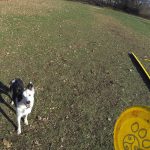 Waiting on cue and situationally is extremely important for disc dog freestyle training. The competition field might not see too much waiting going on as everything is supposed to be happening in flow,... More. The End.
Waiting on cue and situationally is extremely important for disc dog freestyle training. The competition field might not see too much waiting going on as everything is supposed to be happening in flow,... More. The End.
A solid wait is the key because a vault is a complex, team oriented operation. Perfect timing, especially in the learning phase, is absolutely critical. Nothing throws your timing off like a dog who won’t Wait.
A weak Wait will affect the team’s confidence and trust in this complex skill. Trust and confidence are necessary in any complex team oriented operation.
If you don’t have a solid Wait, you probably should not be vaulting your dog.
PositionIn the Play+ philosophy, "Position" is the final stage within the "Next" phase of a Cycle of Play. It acts as a pivotal link between the "Next" phase and a new "Now" phase. More
How far should your dog be away from you for each type of vault? What direction are you going?
Many handlers don’t know the answers to these questions. If you don’t know the answer to these questions, you probably should not be vaulting your dog.
Linear Vaults
A linear vault, where the dog vaults over the handler’s body in a straight line, requires at least 1-1.5 strides between you and your dog.
This distance is required for the dog to easily navigate the approach, and for the handler to get the disc up early enough for the dog to leave the ground for the target.
One step for movement and a half step for collection are required for smooth vaulting.
Reverse Vaults
A reverse vault, where the dog essentially flips off the handler’s body, does not require as much space. 1.5 – 3 feet is about right for most every situation.
Because the Reverse Vault is a flip, you don’t want a lot of linear speed coming in. The dog doesn’t need to carry a bunch of distance and is not collecting to leap forward, but rather collecting for a flip. Flipping backwards while running forward is hard.
Linear speed is counter productive for reverse vaults.
Cue
A complex team skill always requires some kind of cue. Whether it’s eye contact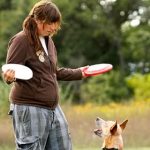 Unsolicited eye contact or Attention is a great way to hook up with a dog. If you have something the dog wants he should give eye contact in order to get access to... More in the appropriate situation, a verbal “Red 29… Red 29”, or a designated physical cue, a cue is what helps us start on the same page.
Unsolicited eye contact or Attention is a great way to hook up with a dog. If you have something the dog wants he should give eye contact in order to get access to... More in the appropriate situation, a verbal “Red 29… Red 29”, or a designated physical cue, a cue is what helps us start on the same page.
When cuing, give the weak, or conditioned cue, before the strong, unconditioned cue. The weak cue, the cue that doesn’t naturally work, should be followed by the strong cue, the cue that naturally works.
This almost always means Verbal then Physical when it comes to disc dog stuff. Our verbal cue for a Linear Vault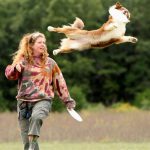 The dog uses the player´s body as a launching pad to jump for a disc. A Vault is a leaping catch from the handler’s body. The dog leaves the ground for the target... More is “Top” (Hattip to Yachi Hirai). Our verbal for a Reverse Vault
The dog uses the player´s body as a launching pad to jump for a disc. A Vault is a leaping catch from the handler’s body. The dog leaves the ground for the target... More is “Top” (Hattip to Yachi Hirai). Our verbal for a Reverse Vault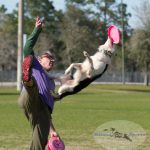 Essentially a flip off of a part of the handler's body, the Reverse Vault is a vault that stays on one side of the handler. If the dog starts the trick in front... More is “Rebound”. It’s a good idea to develop a cadence or rhythm to the verbal then physical cue. So the team is prepared when it’s time to move.
Essentially a flip off of a part of the handler's body, the Reverse Vault is a vault that stays on one side of the handler. If the dog starts the trick in front... More is “Rebound”. It’s a good idea to develop a cadence or rhythm to the verbal then physical cue. So the team is prepared when it’s time to move.
When setting up a vault, there are many potential positional and situational cues. It is likely that your dog is reading one or more of these positional cues instead of to the cue you have taught.
This is almost assuredly true if you have not worked exclusively on cuing and are erratic with your verbal and physical cue timing.
The physical cue is usually a sharp body movement and/or the presentation of the vaulting platform. I tried for years to stop the leg lifting up for the leg vault from being the cue my dog took for the leg vault. It was silly. The presentation of the vaulting platform is the strongest and most reliable cue out there — you almost can’t stop it.
Concept
What is a vault? If you think it’s the dog leaping from your body to get a disc, you are close, but no cigar. The dog uses the handlers body to get the disc. It’s not quite the same thing.
Vaults start from the ground. The handler’s body is the platform from which the dog vaults in order to get the disc, but the vault itself starts from the ground.
A big problem with the concept of vaulting is that people (and their dogs) don’t understand that the vault starts from the ground. Ideally you want the target placed so you can leave the ground for the target via the handler’s body.
If the dog is in the proper position and sees the target, from the ground, the dog will make a plan, while still on the ground, to get the disc. This plan will account for poor placement and timing making success and safety much more likely.
Timing
The previous four keys all have great impact on timing — they create timing. Without understanding and competence with the previous 4 keys, you probably should not be vaulting.
The dog should leave the ground for the target. That’s the proper timing of your toss. The dog either leaves the ground for the target or does not. Also, it should be noted that the disc can be tossed before the handler sets the vaulting platform.
If you think a vault happens off your body you will be late to the party. The dog will have already leapt by the time you throw, and you’ll be trying to stuff the disc into a moving target’s mouth.
Many vaults do have this late timing, tight sequences and interior moves don’t have enough time to execute proper vaulting concepts, but those are the exceptions and not the rule.
Placement
Knowing where to place the disc and being able to put it there are absolutely key to safe and successful vaulting.
If you can’t set and hit a proper target 95 times out of 100, you should not be vaulting. This really can’t be stressed enough. Many, many people are currently vaulting who can’t place a disc on a well chosen target reliably. Don’t be one of those people.
The disc should be coming down to land on the target on a properly timed vault. It’s not enough to hit the target, you have to hit the target at the same time, with the same trajectory every time. The vault can be caught at the apex of it’s flight as well if the trajectory is predictable.
Trajectory that hits the target on the way up could be real trouble in the wind or with a slight timing mistake.
Landing
The most important aspect of a vault in terms of safety is a smooth landing. It’s how we at Pawsitive Vybe determine if a vault is safe or not: Did the dog land smoothly with balance and movement?
Buckles, freezes, clunks, and other erratic, non-smooth or poorly balanced landings should be avoided. “It’s not the drop that kills ya, it’s the landing.”
A dog should land on their front feet first.
On linear vaults they should land on their fronts, funneling the movement into the shoulders, chest and neck. The rear legs should slide forward, in smooth, balanced motion as the dog releases the initial shock absorption from the front end using that linear movement and running through the finish.
On reverse vaults things get a little bit harder to read, but the same is generally true. The front feet initially funnel to the shoulders, chest and neck, and the rear legs come down to walk out of the flip. Smooth, well balanced movement is key.
If the previous 6 keys are installed and understood by your team, then landings are probably not an issue. If you have some issues they probably have to do with style of play and reward placement.
Where you generally put the next disc is where the dog is going to want to go next. This being the case, and disc dogs being efficient little killers of plastic, the dog will start to cheat the landing to set up what he or she believes is the next trick.
If your dog is turning back towards you on linear vaults, just start sending some throws out in line with the vaulting direction (directionally feed).
If the dog is landing on their rear feet first, you can get them to land more on their fronts by offering a bite on a disc in your hand. This cued bite Treatment also works for reverse vaults that finish on all fours instead of front feet first.
The entire landing is shaped by, and can be shaped or altered by, reward placement. Where you put that next disc can change the dog’s landing.





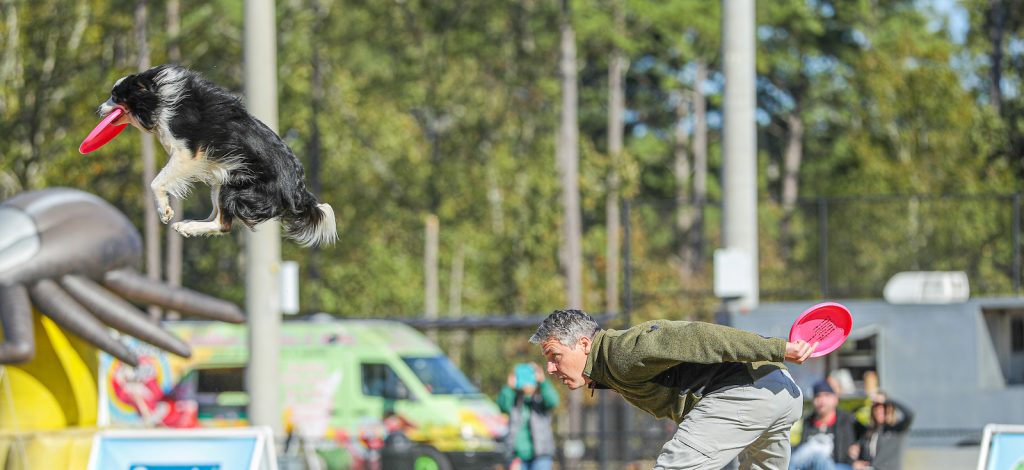
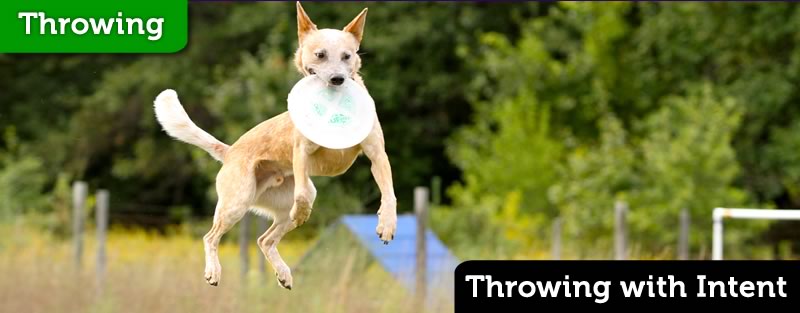
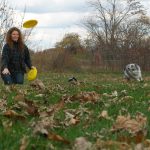
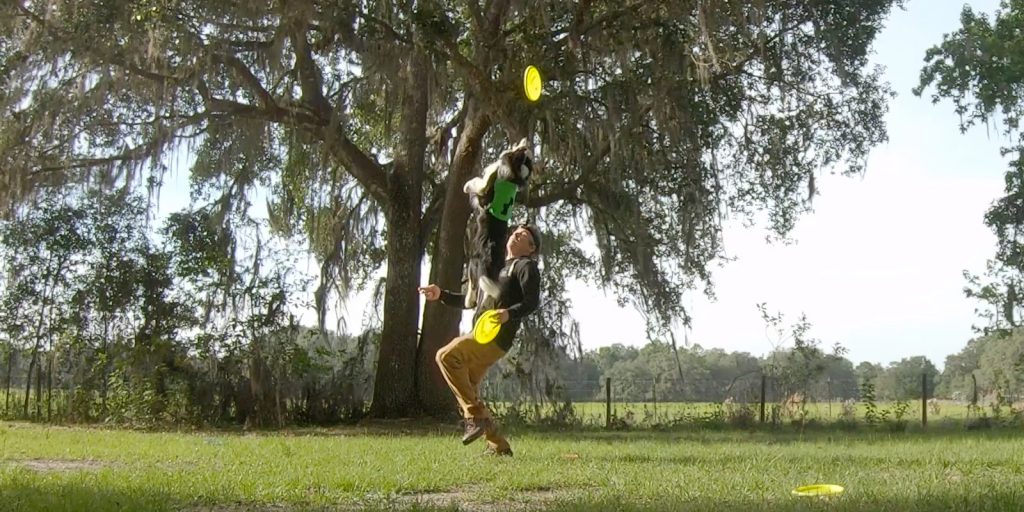
Responses